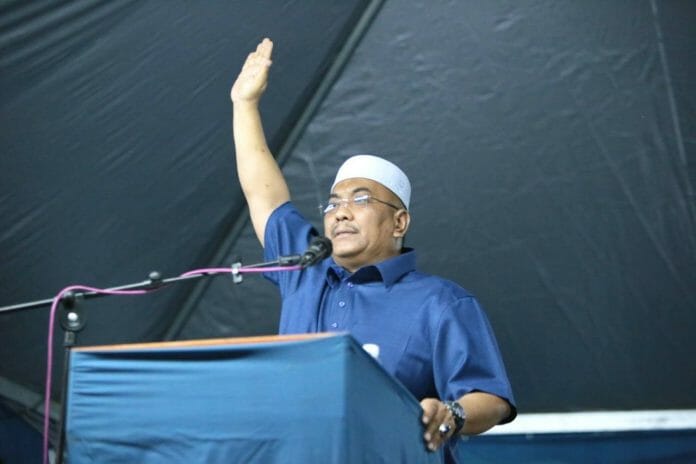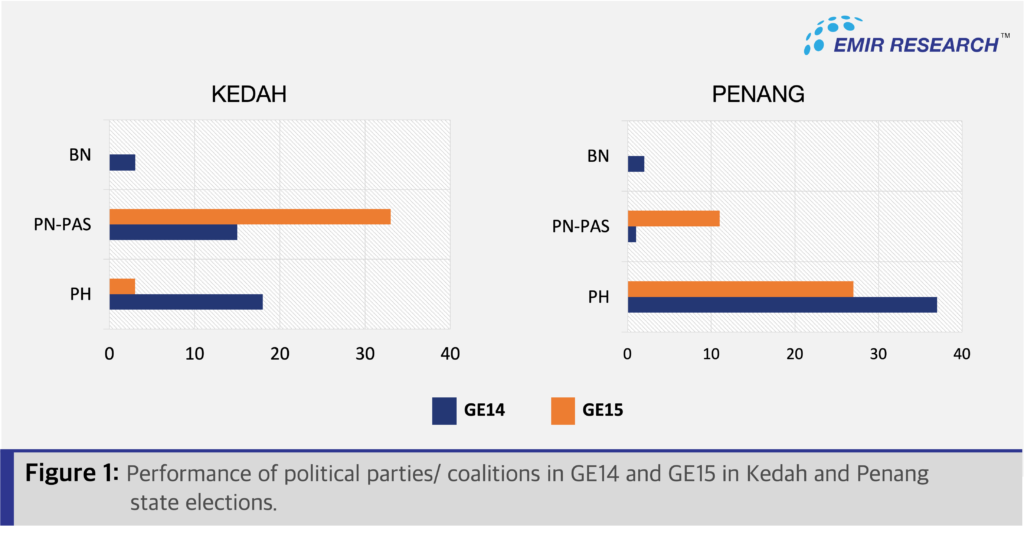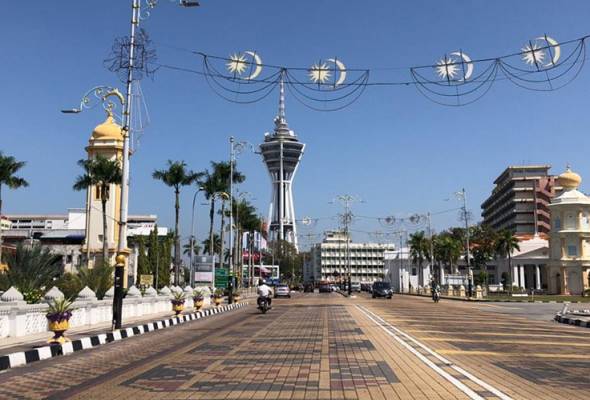
Published by BusinessToday, The Malaysian Insight & AstroAwani, image by BusinessToday.
Last Saturday’s six-state election resulted in a return to the political status quo (3-3), with the unity government winning in Selangor, Penang and Negeri Sembilan while the Perikatan Nasional (PN) opposition coalition will be leading Kedah, Kelantan, and Terengganu.
However, many consider the recent progress of PN in Selangor, a stronghold of PH, to be a significant political blow to the Anwar administration, revealing a growing polarisation within Malaysia that is stronger than ever.
After all, the PN president, Tan Sri Muhyddin Yassin, was not talking through one’s hat when he projected the coalition could be winning big in the state election.
In the northern region, PN has made significant inroads in Penang and had a landslide win in Kedah.
The recent success of PN in Penang and Kedah demonstrates that the coalition can win big in both general and state elections. This was in doubt when in 2018, PAS only won one seat in Penang (Penaga).
Among the think tanks that projected the state election outcomes, EMIR Research accurately predicted 38 of the 40 seats up for election in Penang while making close calls on seven more seats. Two seats were a blind spot, the Bertam and Sungai Acheh constituencies, where BN won by a narrow margin in both instances.
On the other hand, the research firm accurately predicted every one of the 36 seats up for election in Kedah, while another five seats were close calls. Derga, Bukit Selambau, Sidam, Lunas, and Kulim—all of which were won by PN, except Sidam, won by PH.
The graph (Figure 1) shows the number of seats won by political parties in the 14th and 15th state elections, respectively, in Kedah and Penang. With the current election, PN-PAS’s support climbed from 15 seats in Kedah to 33 seats, reflecting this trend. While there is an apparent downward trajectory for PH, the coalition currently only holds three seats in Kedah, down from 18 seats in the 14th state election.

Instead of securing a simple majority in Kedah, PN secured a two-third winning majority (33 out of 36 seats). On the other hand, in Penang, after only obtaining one seat by PAS in GE14 (Penaga), the coalition has managed to secure 11 seats in the recent state election paving significant inroads in the state.
Based on EMIR Research’s analysis, overall, PN made the biggest jump mainly through PAS (83% success rate), which won 105 seats out of 127 seats contested in the six states.
On the other hand, DAP remains PH’s biggest deposit (98% success rate) by winning almost all the seats contested (won 46 out of the 47 seats contested).
To emphasise, the unity government has lost a total of 44 seats out of 76 in the northern region — 11 seats in Penang and another 33 seats in Kedah.
While the number may not be significant compared to the total wipeout on the east coast, the northern states (especially Penang), once a stronghold of DAP, are facing resistance from the PN movement.
The results of the state elections, particularly in Kedah and Penang, show that the PH-BN only won in its set deposit areas, with the unity government failing to capture any of the PN seats. Contrarily, PN has been able to seize control of many of the seats previously under the control of PH or BN, in addition to winning its fixed deposit.
The phenomenon amply demonstrates the high rate of vote transferability from PH and BN in the 14th state election to PN in the 15th state election, wherein most votes in these states were swung to the current opposition party.
According to the voting patterns in the two states, PN continues to be the alternative party of choice in Malay majority seats.
Particularly on the Penang mainland, the voting patterns in several locations, including Pinang Tunggal, Permatang Berangan, and Sungai Dua, demonstrate a significant shift in voting patterns. These constituencies, which were once BN strongholds until the 2018 election, the seats were occupied by PH, and now all of them are held by PN.
It cannot be denied that a handful of politicians were confident of non-Malays’ vote for the unity government, as PN leaders are often painted as the cause of political polarisation across ethnic groups in Malaysia. However, the voter turnout rate in the recent state election showed otherwise.
For instance, the preliminary analysis done by Bridget Walsh found that the number of Indian supporters for PH in Penang has decreased by 17%, while the number of Indian supporters for PN has climbed by 29% in the state election, which had a comparably bigger margin.
The decision to not run MIC leaders in the state election, the ongoing pressure on the quota system, and the “Ramasamy effect” might be among the contributing factors to the vote swing.
These patterns point towards significant changes in the social fabric since the last GE15 and make it apparent that this is not just a “green wave” anymore.
As extensively circulated, one of the prime strategies for winning over Malay voters was the combined might of the PH and BN alliance.
However, the results of this election make it quite clear that voters from other races, besides Malay voters, are still in doubt about the PH-BN alliance.
Is BN playing a pivotal role in garnering popularity among Malay voters, or is the party merely undermining the success rate of PH?
Ineffective communication tools and channels during campaigning
Despite launching several initiatives via the inclusive Madani Economy framework and providing aid, election goodies and assistance to lower- and middle-income rakyats throughout the election campaign, the unity government could not effectively utilise its resources and win the favour of the general populace.
Why? What went wrong? Where it all went wrong?
These initiatives, for instance, did not fully emphasise how they would generate revenue for the lower and middle-income rakyat to better cope with the risks associated with the rising costs of inflation because there were no proper and effective channels to deliver the benefits it holds to the rakyat.
The uneasy connection among coalition partners, in addition to the external communication elements, is undoubtedly the leading cause of PH-BN’s internal demise.
Concerning the “secretive”, ongoing, irreconcilable divisions, it is evident that envisioning a combined team effort might be an unattainable pipe dream. Thus, fixing the PH and BN leaders’ estranged relationship is important, particularly at the grassroots level.
Emotional vs rational campaigning
Although the unity government used pragmatic and rational campaigning to deliver the achievements and manifesto for the states, it was unable to defeat the on-ground sentiments by PN, this is inclusive of the strong ethno-religious narrative used by the political coalition.
The use of Sanusi as a campaign focal point, for example, was a poor decision on the part of PH-BN even if the activities of Sanusi were unacceptable and a crime within the law, as this, in reality, increased the popularity of Sanusi and PN.
The voters in Kedah had unmistakably cast their ballots based on the on-ground sentiment or emotion, portraying Sanusi as the “victim” rather than holding him responsible for his unlawful acts. What is more, they were prepared to jeopardise their well-being and the future of their generation.
By data, in the latest election Sanusi managed to receive 21,823 (79.08%), double the amount of support he received in the 14th Kedah state election (10,626 votes or 46.31%).
The “Sanusi factor”, albeit not the primary cause, had a role in the ascent of PN among Malay voters in the recent state election.
In summary, despite winning 146 (60%) of the overall 245 seats in the six states compared to PH-BN, 99 (40%), the popularity vote of PH-BN, 3,399,472 (49.5%) remains slightly higher compared to PN 3,382,454 (49.3%).
However, if the current course is maintained, this administration would experience a greater loss in the approaching GE16.
This therefore points to a potential realignment of the unity government in order to promote and work towards a progressive and inclusive Malaysia.
As the sayings goes, “the buck stops here”, politicians should now stop politicking any longer and focus on fixing the economy and improving the well-being of rakyats.
Jachintha Joyce is Research Assistant at EMIR Research, an independent think tank focused on strategic policy recommendations based on rigorous research.

